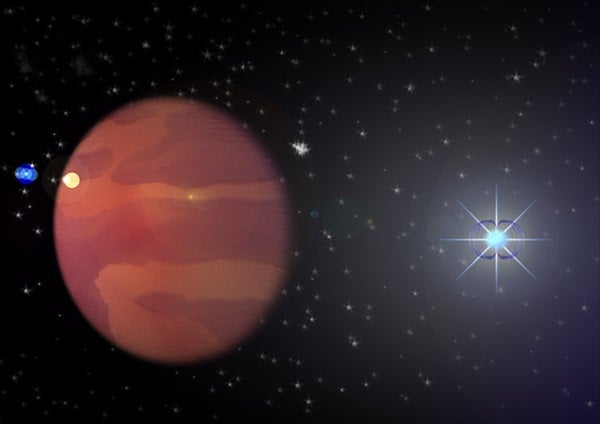The system is the first of its type to be found. The two stars are low in mass and have a weak mutual gravitational attraction as they are separated by about a quarter of a light-year, or 1.6 trillion miles (2.5 trillion kilometers). Despite the frailty of the system, it has stayed together for billions of years, but its stars are cooling down to a dark demise.
Methane dwarfs are on the star/planet boundary and are about the size of the giant planet Jupiter. They have temperatures of less than 1800° Fahrenheit (1000° Celsius) — in comparison, the Sun’s surface is at 9900°F (5500°C). Methane is a fragile molecule destroyed at warmer temperatures, so it is only seen in cool stars and objects like Jupiter. Neither giant planets nor T-dwarf stars are hot enough for the hydrogen fusion that powers the Sun to take place, meaning that they simply cool and fade over time.
White dwarfs are the end state of stars similar to and including the Sun. Once such stars have exhausted the available nuclear fuel in their cores, they expel most of their outer layers into space, forming a remnant planetary nebula and leaving behind a hot but cooling core, or white dwarf, about the size of Earth. For our Sun, this process will begin in about 5 billion years.
In the newly discovered binary, the remnant nebula has long since dissipated, and all that is left is the cooling white dwarf and methane dwarf pair.
“In about 6 billion years’ time, when our Sun dies and becomes a white dwarf itself, the stars in the newly discovered system will have changed dramatically,” said Avril Day-Jones from the University of Chile. “The methane dwarf will have cooled to around room temperature, and the white dwarf will have cooled to 4900°F (2700°C), or the temperature of the methane dwarf at the start of its life.”
This binary is providing a crucial test of the physics of ultra-cool — temperatures less than 1800°F (1000°C) — stellar atmospheres because the white dwarf lets us establish the age of both objects. It calibrates properties of the methane dwarf such as its mass, making it a kind of Rosetta stone for similar stars with complex, hazy, ultra-cool atmospheres.
The methane dwarf was identified in the UKIRT Infrared Deep Sky Survey (UKIDSS) as part of a project to identify the coolest objects in the galaxy. The Gemini North Telescope in Hawaii measured the temperature and spectrum.
The team then found that the methane dwarf shares its motion across the sky with a nearby blue object cataloged as LSPM 1459+0857. They studied the blue object using the world’s largest optical telescope, the European Southern Observatory’s (ESO) Very Large Telescope (VLT) in Chile. The new VLT observations revealed the blue object to be a cool white dwarf and companion to the methane dwarf. The objects were thus re-christened LSPM 1459+0857 A and B.
The two stars are today separated by at least 1.6 trillion miles (2.5 trillion km), but would have been closer in the past before the white dwarf formed. Once the star that formed the white dwarf reached the end of its life and expelled its outer layers, the loss of mass weakened the gravitational pull between the stars, causing the methane dwarf to spiral outward to create the gravitationally fragile system that we see today. But the current age of the white dwarf indicates that this system has survived for several billion years. So the new discovery shows that despite their fragility, such binaries are able to remain united even as they move through the maelstrom of the disk of our galaxy.
“Binary systems like this provide vital information and allow us to better understand ultra-cool atmospheres and the very low-mass dwarfs and planets they enshroud,” said David Pinfield from the University of Hertfordshire, United Kingdom. “The fact that these binaries survive intact for billions of years means that we could find many more lurking out there in the future.”
The system is the first of its type to be found. The two stars are low in mass and have a weak mutual gravitational attraction as they are separated by about a quarter of a light-year, or 1.6 trillion miles (2.5 trillion kilometers). Despite the frailty of the system, it has stayed together for billions of years, but its stars are cooling down to a dark demise.
Methane dwarfs are on the star/planet boundary and are about the size of the giant planet Jupiter. They have temperatures of less than 1800° Fahrenheit (1000° Celsius) — in comparison, the Sun’s surface is at 9900°F (5500°C). Methane is a fragile molecule destroyed at warmer temperatures, so it is only seen in cool stars and objects like Jupiter. Neither giant planets nor T-dwarf stars are hot enough for the hydrogen fusion that powers the Sun to take place, meaning that they simply cool and fade over time.
White dwarfs are the end state of stars similar to and including the Sun. Once such stars have exhausted the available nuclear fuel in their cores, they expel most of their outer layers into space, forming a remnant planetary nebula and leaving behind a hot but cooling core, or white dwarf, about the size of Earth. For our Sun, this process will begin in about 5 billion years.
In the newly discovered binary, the remnant nebula has long since dissipated, and all that is left is the cooling white dwarf and methane dwarf pair.
“In about 6 billion years’ time, when our Sun dies and becomes a white dwarf itself, the stars in the newly discovered system will have changed dramatically,” said Avril Day-Jones from the University of Chile. “The methane dwarf will have cooled to around room temperature, and the white dwarf will have cooled to 4900°F (2700°C), or the temperature of the methane dwarf at the start of its life.”
This binary is providing a crucial test of the physics of ultra-cool — temperatures less than 1800°F (1000°C) — stellar atmospheres because the white dwarf lets us establish the age of both objects. It calibrates properties of the methane dwarf such as its mass, making it a kind of Rosetta stone for similar stars with complex, hazy, ultra-cool atmospheres.
The methane dwarf was identified in the UKIRT Infrared Deep Sky Survey (UKIDSS) as part of a project to identify the coolest objects in the galaxy. The Gemini North Telescope in Hawaii measured the temperature and spectrum.
The team then found that the methane dwarf shares its motion across the sky with a nearby blue object cataloged as LSPM 1459+0857. They studied the blue object using the world’s largest optical telescope, the European Southern Observatory’s (ESO) Very Large Telescope (VLT) in Chile. The new VLT observations revealed the blue object to be a cool white dwarf and companion to the methane dwarf. The objects were thus re-christened LSPM 1459+0857 A and B.
The two stars are today separated by at least 1.6 trillion miles (2.5 trillion km), but would have been closer in the past before the white dwarf formed. Once the star that formed the white dwarf reached the end of its life and expelled its outer layers, the loss of mass weakened the gravitational pull between the stars, causing the methane dwarf to spiral outward to create the gravitationally fragile system that we see today. But the current age of the white dwarf indicates that this system has survived for several billion years. So the new discovery shows that despite their fragility, such binaries are able to remain united even as they move through the maelstrom of the disk of our galaxy.
“Binary systems like this provide vital information and allow us to better understand ultra-cool atmospheres and the very low-mass dwarfs and planets they enshroud,” said David Pinfield from the University of Hertfordshire, United Kingdom. “The fact that these binaries survive intact for billions of years means that we could find many more lurking out there in the future.”










